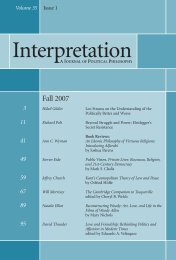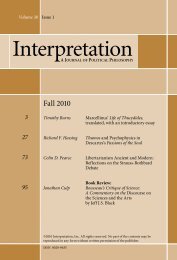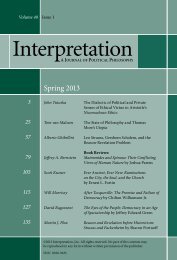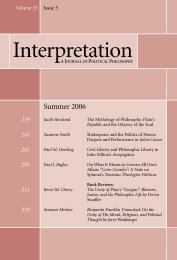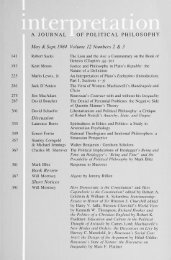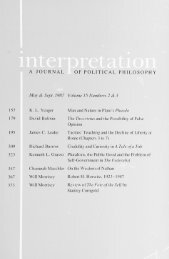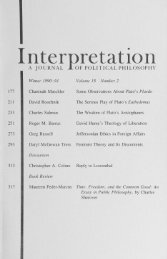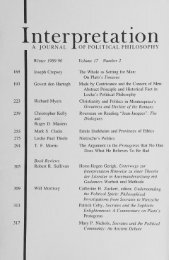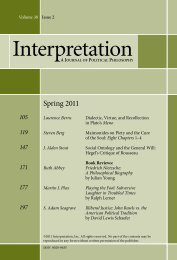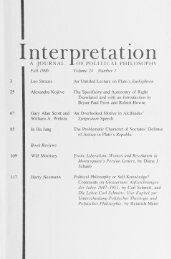Spring 2010 - Interpretation
Spring 2010 - Interpretation
Spring 2010 - Interpretation
Create successful ePaper yourself
Turn your PDF publications into a flip-book with our unique Google optimized e-Paper software.
Creation as Parable in Maimonides’ Guide of the Perplexed<br />
2 6 7<br />
of the text, its presumed true meaning. (For a full discussion of these four<br />
parables and their implications, see Weiss 2008.) Although he presents the<br />
four as if they all say more or less the same thing in different ways, the fact<br />
is that they differ significantly from one another in their implications. Close<br />
attention to them reveals that they are ordered in such a way as to build successively<br />
toward a rather startling view of the relationship between the Torah<br />
text’s peshat and its hidden meaning. The first parable, which compares the<br />
words of the Torah to a cord by which the cool but remote waters of a well<br />
can be reached, suggests that the peshat, the text’s surface meaning, has<br />
instrumental value; whether or not it might have intrinsic value as well is<br />
left unaddressed. In the second parable, in which the peshat is compared to<br />
a taper which, though almost worthless in itself, is nevertheless valuable for<br />
finding a lost pearl, Maimonides grants the taper—and hence the peshat—<br />
instrumental value but explicitly denies it intrinsic value: it is worth, he says,<br />
a mere issar. In the third parable, a pearl lies hidden in a dark house that<br />
is full of furniture, and the only way it can be found is by the lighting of a<br />
lamp. Here the peshat is the analogue of the dark furniture-filled house, so<br />
that it now not only has no intrinsic value, but it lacks even instrumental<br />
value. Moreover, one would have to conclude that, according to this parable,<br />
the peshat occludes the text’s deeper meaning if “an act of understanding,”<br />
the analogue of the lamp, is required to penetrate through it to the text’s<br />
secret. The final parable likens the peshat to a setting of silver filigree, and the<br />
Torah’s hidden meaning to the golden apple encased within it. Although both<br />
are beautiful, Maimonides says, gold is more beautiful than silver. Moreover,<br />
Maimonides makes the point that the apple, when seen at a distance, appears<br />
to be solidly silver. It would seem, then, that not only is the silver filigree not<br />
instrumentally helpful for discerning the golden apple within, but it deceives<br />
all but the most judicious into believing that there is no apple but a silver<br />
one. It is not wholly off the mark to see Maimonides at last, in this final parable,<br />
according the surface text intrinsic value insofar as he compares it to<br />
silver. Yet for Maimonides the peshat’s intrinsic value does not lie in advancing<br />
truth but rather in enhancing human associations—that is, in improving<br />
both individual moral character, on the one hand, and social and political<br />
relations among people, on the other. Although peshat is, therefore, beautiful<br />
in its way—as beautiful as silver—it nevertheless conceals the truth from<br />
ordinary people and even fools them: it causes all but those with the keenest<br />
vision to believe that it is the truth and that there is no deeper and more<br />
genuine truth.



